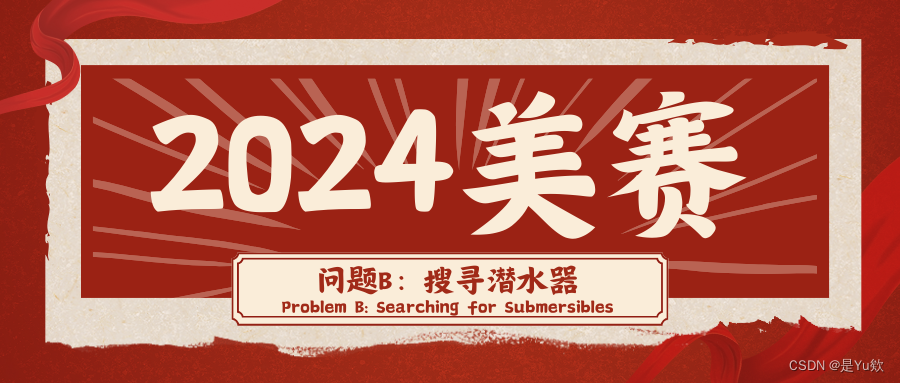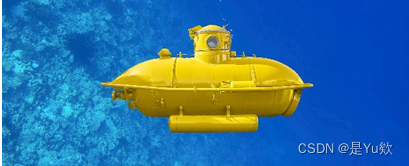【2024美赛】B题(中英文):搜寻潜水器Problem B: Searching for Submersibles
- 写在最前面
- 2024美赛翻译 —— 跳转链接
- 中文赛题
- 问题B:搜寻潜水器
- 你的任务是:
- 词汇表
- 英文赛题
- Problem B: Searching for Submersibles
- Your tasks are to:
- Glossary
写在最前面
注:中文初稿由ChatGPT-4自动翻译,Yu进行了细节上的完善和调整,欢迎留言补充。本文仅供学习和交流使用,祝大家取得超乎预期的好成绩!

2024美赛翻译 —— 跳转链接
【2024美赛】在COMAP比赛中使用大型语言模型和生成式AI工具的政策Use of Large Language ModelGenerative AI Tools in COMAP Contests
【2024美赛】A题(中英文):资源可用性与性别比例Problem A: Resource Availability and Sex Ratios
【2024美赛】B题(中英文):搜寻潜水器Problem B: Searching for Submersibles
【2024美赛】C题(中英文):网球中的势头Problem C: Momentum in Tennis
【2024美赛】D题(中英文):五大湖水资源问题Problem Problem D: Great Lakes Water Problem
【2024美赛】E题(中英文):房产保险的可持续性Problem E: Sustainability of Property Insurance
【2024美赛】F题(中英文):减少非法野生动物贸易Problem F: Reducing Illegal Wildlife Trade
中文赛题

问题B:搜寻潜水器
希腊的海洋游轮迷你潜艇公司(MCMS)制造能够将人类带到海洋最深处的潜水器。潜水器被运送到位置并从主船上无缆释放。MCMS现在希望使用他们的潜水器带游客探险爱奥尼亚海底的沉船残骸。然而,在他们能够做到这一点之前,他们需要通过开发安全程序以应对与主船失去通信和可能的机械故障(包括潜水器失去推进力)的情况,从而赢得监管机构的批准。特别是,他们希望你开发一个模型来预测潜水器随时间的位置。与陆地或海面上的典型搜救不同,故障潜水器可能会发现自己位于海底或某个水下中性浮力点。其位置还可能受到洋流、海水不同密度和/或海底地形的影响。
你的任务是:
-
定位 - 开发一个模型(或多个模型)预测潜水器随时间的位置。
- 这些预测与哪些不确定性相关?
- 潜水器可以定期向主船发送哪些信息以减少这些不确定性?潜水器需要哪些设备才能做到这一点?
-
准备 - 你会推荐公司在主船上携带哪些额外的搜索设备以备不时之需?你可以考虑不同类型的设备,但也必须考虑这些设备的可用性、维护、准备和使用成本。如果需要,救援船需要带来哪些额外的设备来协助?
-
搜索 - 开发一个模型,使用你的位置模型提供的信息来推荐初始部署点和搜索模式,以最小化定位丢失潜水器的时间。确定随时间和累积搜索结果找到潜水器的概率。
-
推广 - 你的模型如何扩展以考虑其他旅游目的地,如加勒比海?当有多个潜水器在相同的一般区域移动时,你的模型将如何改变?准备一份不超过25页的报告,提供你的计划详情。包括一份两页的备忘录,地址是希腊政府,以帮助赢得批准。
你的PDF解决方案总共不超过25页,应包括:
- 一页摘要页。
- 目录。
- 你的完整解决方案。
- 参考文献列表。
- AI使用报告(如果使用,不计入25页限制内。)
注意:对于完整的MCM提交,没有特定的最低页数要求。你可以使用最多25页的总页数来进行所有解决方案工作和任何你想包括的额外信息(例如:图纸、图表、计算、表格)。接受部分解决方案。我们允许谨慎使用AI,如ChatGPT,尽管创建解决方案不必要。如果你选择使用生成式AI,你必须遵循COMAP的AI使用政策。这将导致你必须在PDF解决方案文件末尾添加额外的AI使用报告,且不计入解决方案的25页总页数限制内。
词汇表
潜水器:潜水器是一种需要由更大的水上交通工具或平台运输和支持的水下车辆。这与潜艇不同,潜艇是自给自足的,能够在海上进行长时间的独立操作。
中性浮力发生在物体的平均密度等于其所浸没的流体的密度时,结果是浮力与否则会使物体沉没(如果物体的密度大于其所浸没的流体)或上升(如果它较轻)的重力平衡。具有中性浮力的物体既不会下沉也不会上升。
英文赛题
Problem B: Searching for Submersibles
Maritime Cruises Mini-Submarines (MCMS), a company based in Greece, builds submersibles capable of carrying humans to the deepest parts of the ocean. A submersible is moved to the location and deployed untethered from a host ship. MCMS now wishes to use their submersible to take tourists on adventures exploring the bottom of the Ionian Sea for sunken shipwrecks. Before they can do this, however, they need to win approval from regulators by developing safety procedures in case of a loss of communication to the host ship and possible mechanical defects including a loss of propulsion of the submersible. In particular, they would like you to develop a model to predict the location of the submersible over time. Unlike in a typical search and rescue on land or on the surface of a sea, the defective submersible could potentially find itself positioned on the sea floor or at some point of neutral buoyancy underwater. Its position could further be affected by currents, differing densities in the sea, and/or the geography of the sea floor.
Your tasks are to:
-
Locate - Develop a model(s) that predicts the location of the submersible over time.
- What are the uncertainties associated with these predictions?
- What information can the submersible periodically send to the host ship to decrease these uncertainties prior to an incident? What kinds of equipment would the submersible need to do so?
-
Prepare - What, if any, additional search equipment would you recommend the company carry on the host ship to deploy if necessary? You may consider different types of equipment but must also consider costs associated with availability, maintenance, readiness, and usage of this equipment. What additional equipment might a rescue vessel need to bring in to assist if necessary?
-
Search - Develop a model that will use information from your location model(s) to recommend initial points of deployment and search patterns for the equipment so as to minimize the time to location of a lost submersible. Determine the probability of finding the submersible as a function of time and accumulated search results.
-
Extrapolate - How might your model be expanded to account for other tourist destinations such as the Caribbean Sea? How will your model change to account for multiple submersibles moving in the same general vicinity? Prepare a report of no more than 25 pages providing the details of your plan. Include a two-page memo of your report addressed to the Greek government to help win approval.
Your PDF solution of no more than 25 total pages should include:
- One-page Summary Sheet.
- Table of Contents.
- Your complete solution.
- References list.
- AI Use Report (If used does not count toward the 25-page limit.)
Note: There is no specific required minimum page length for a complete MCM submission. You may use up to 25 total pages for all your solution work and any additional information you want to include (for example: drawings, diagrams, calculations, tables). Partial solutions are accepted. We permit the careful use of AI such as ChatGPT, although it is not necessary to create a solution to this problem. If you choose to utilize a generative AI, you must follow the COMAP AI use policy. This will result in an additional AI use report that you must add to the end of your PDF solution file and does not count toward the 25 total page limit for your solution.
Glossary
Submersible: A submersible is an underwater vehicle which needs to be transported and supported by a larger watercraft or platform. This distinguishes submersibles from submarines, which are self-supporting and capable of prolonged independent operation at sea.
Neutral buoyancy occurs when an object’s average density is equal to the density of the fluid in which it is immersed, resulting in the buoyant force balancing the force of gravity that would otherwise cause the object to sink (if the body’s density is greater than the density of the fluid in which it is immersed) or rise (if it is less). An object that has neutral buoyancy will neither sink nor rise.







)




复习提纲21)

)





)